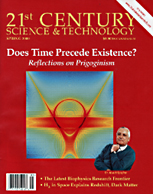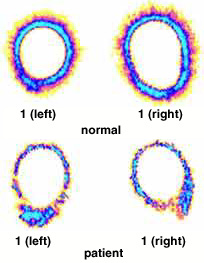| Spring 2000 Vol. 13, No. 1
FEATURES
Does Time Really Precede Existence?
A Reflection on Prigoginism
Dino De Paoli
The distinguishing characteristic of life can best be seen in man’s unique capability to create a culture that fosters the continuing creative breakthroughs necessary for moving civilization forward. It cannot be understood from the lower standpoint of physical processes.
A Note on Nonlinearity
Lyndon H. LaRouche, Jr.
The Growing Evidence of Planets Beyond Our Solar System
Marsha Freeman
The discovery of 28 probable extrasolar planets, over the past five years, has thrown conventional theories of planet formation into turmoil.
Interview with Prof. Vladimir Voeikov
A Russian Biologist Comments on
What Distinguishes Living Systems
A leading researcher discusses the breaking frontiers of biophysics presented at the Second International A.G. Gurwitsch Conference, held in Moscow in September 1999.
NEWS
SPECIAL REPORT
Develop the Amazon!
Brazilian Senator Asks: ‘Why Should Brazilians Go Hungry to Please the Queen of England?’
NUCLEAR REPORT
South Africa Plans to Mass Produce
Pebble-Bed HTR Nuclear Reactors
Jonathan Tennenbaum
BIOLOGY AND MEDICINE
Promising Cancer Vaccines Move from Lab to Clinic
Colin Lowry
WASHINGTON REPORT
Clinton Ups Budgets for Science, Space
Marsha Freeman
1999 INDEX
Subject, Author
DEPARTMENTS
EDITORIAL
Time . . . and Philosophical Illiteracy
Laurence Hecht
LETTERS
RESEARCH COMMUNICATIONS
Discovery of Hydrogen in Space Explains Dark Matter and Redshift
Paul Marmet
VIEWPOINT
U.S. Uranium Enrichment Privatized to Death?
Richard Freeman
NEWS BRIEFS
BOOKS
Krimsky’s Kaos: The Hormonal Bias of a Bioethicist
A review by Dr. Stephen H. Safe of Hormonal Chaos by Sheldon Krimsky
Is There Life on Mars? The Quest Continues
A review by Marsha Freeman of The Search for Life on Mars: Proceedings of the 1st UK Conference,Julian Hiscox, Ed. and of The Search for Life on Mars by Malcolm Walter
Looking Through the Technology of Glass
A review by Elisabeth Pascali of Glass: From the First Mirror to Fiber Optics: The Story of the Substance That Changed the World by William S. Ellis
Sloppy Presentation of Space Science
A review by Marsha Freeman of five videos for children by produced by Schlessinger Media |




